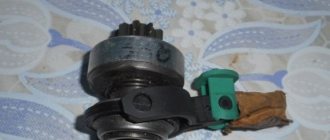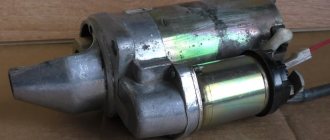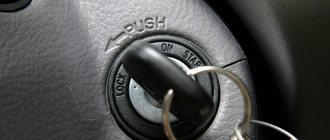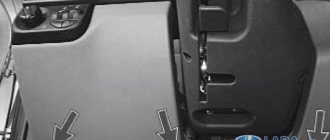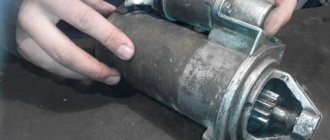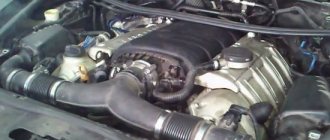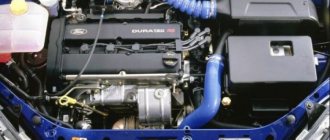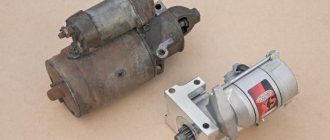It is known that bendix is an element located in the starter housing, which is a small-sized clutch. It consists of a gear, a pair of cages, springs and a retaining ring. It’s difficult to imagine the car’s operation without it.
It is necessary to minimize the load from the starter and ensure its safety from various damages when starting the engine. Also, the engine starts silently with its help, which has a positive effect on the operation of the car. If it does not work, then it is urgently necessary to bring it into working condition or replace it.
Causes
Why is there a crackling and grinding sound when starting the engine? This question is often asked by beginners and not-so-motorists. Many people are frightened by the strange sound heard when starting the engine. Although in many cases this is not a difficult problem. But it still needs to be eliminated, and for this it’s good to know where to look for the problem. There are several places that produce crackling and grinding noises during startup:
- Starter;
- Flywheel;
- Roller mounting bolt (timing).
Knowing the main places of breakdowns, you will quickly find out where the main problem is. For a more accurate diagnosis, open the hood and ask someone to start the engine. If there are problems with the starter and flywheel, a cracking noise will be heard from the rear of the engine when the bolt is unscrewed at the front.
Starter-related breakdowns
- There is a short circuit in the relay winding;
- there are breaks in the power supply circuit;
- breakage of the solenoid relay;
- brushes are worn out;
- the nickels at the starter solenoid relay are stuck or burnt;
- The switch has failed.
In general, after you have disassembled the starter, if you haven’t found any damage, then you need to clean all the components there and lubricate them. Then everything can be put back together.
Starter malfunctions
Starter malfunctions are divided into two categories
- mechanical failure or wear
- damage to the electrical circuit
Since the motor shaft spin-up device consists of two electrical elements, damage to the electrical circuit is also divided into two subcategories:
- electric motor malfunction
- Solenoid relay malfunction
Malfunction of the mechanical part of the starter can be repaired by replacing the bearings or bendix.
Failures of the electrical component of the structure are eliminated by replacing the entire blocks, perhaps with the exception of replacing the carbon brushes.
The starter bendix does not turn
There may be several reasons for this situation. First of all, you need to pay attention to the battery. It may either be discharged or faulty. There are several ways to find out if the battery is at fault:
- the solenoid relay clicks, the lights on the panel do not light up, and the starter bendix does not turn;
- certain clicks are heard, but the lights still go out;
- the system shows no signs of life.
In this case, you just need to charge the battery, but try to figure out why it was discharged in order to prevent similar problems from occurring.
Problems can also be caused by a faulty solenoid relay. There are several signs here:
- you can hear the characteristic buzz of the starter, but the engine does not rotate;
- the starter does not make noise;
- the relay is activated, but the engine does not crank;
- Bendix does not engage the flywheel.
Checking the relay is simple - you need to apply voltage directly to its control terminal. If the engine starts, then, most likely, the relay contacts have burnt out. Clearing the nickels will correct the situation.
How to determine if the starter is faulty
You can quickly determine if the starter is malfunctioning based on its characteristic symptoms. The table below presents the most basic of them and indicates possible causes of breakdowns.
| Symptom | Malfunction | Cause |
| Starter cranks | The planetary mechanism has failed | Water got inside and washed away the grease. As a result, the bushings and teeth of the planetary gear wore out. Incorrect adjustment of the fuel equipment of a diesel engine can lead to reverse impact of the ring gear on the Bendix drive gear. |
| Bendix failed | Bendix springs sag | |
| Starter clicks | Mass has disappeared on the body | Oxidation or breakage of the ground wire |
| There is not enough starting current to operate the starter | The battery is discharged or shorted | |
| The brushes are worn out | Natural mechanical wear, brushes need to be replaced | |
| The solenoid relay is faulty | Burnt out winding or contact plates | |
| The anchor is out of order | The rotor laminae are worn out, a short-circuit to ground has occurred in the armature | |
| The starter turns hard | Rotor bushings are worn out | Water got in, grease washed out |
| Shorted the brush assembly to ground | Water has entered, brush assembly wear | |
| Stator winding shorted to ground | Water entered, the insulation of the stator winding was destroyed | |
| Armature winding short circuit | Water has entered, armature winding insulation is damaged | |
| When starting the starter, a metallic grinding noise is heard | Bendix bushing worn out | Water got in, as a result, the grease was washed out or natural wear of the part occurred |
| Seizures have formed on the flywheel crown | ||
| The bushing on the bendix freewheel shaft is worn out | ||
| The starter works when cold, but clicks when hot | Solenoid relay malfunction | Solenoid relay core stuck |
| The springs in the brush assembly have sagged | The springs have become hot due to long use and overheating of the starter. | |
| Bushings are worn out | Grease has washed out | |
| The contact area of the plates (nickels) has decreased | Burning nickels | |
| The minus on the brush assembly disappears | The contacts have oxidized and when heated, current stops flowing to them |
The design of a car engine starter and its operating principle
The main components of the starter:
- electric motor;
- solenoid relay;
- gear with bendix;
In a nutshell, a flywheel with a ring gear is installed on the engine crankshaft. When the starter is turned on, the starter gear meshes with the flywheel crown and the electric motor turns the crankshaft. After the engine starts, the starter overrunning clutch disengages the gear from the shaft when the engine speed exceeds the starter speed.
- If we take a closer look at the starter, its electric motor consists of a housing, inside of which there is a stator and a rotor rotating in two bushings.
- The brush assembly consists of three or four brushes, which are supplied with voltage from the battery. The brushes, in turn, connect to part of the rotor and supply voltage to it, causing the starter motor to rotate.
- The gear and bendix, located on the rotor shaft, moving forward and backward along it, engage with the flywheel. The solenoid relay turns the electric starter into operation.
The solenoid relay is an electromagnet with a coil and a core. The core, under the influence of the electromagnetic field, begins to move to the side, while the fork connecting the core and the bendix pushes the bendix and gear along the shaft forward to engage it with the flywheel.
The relay has two contacts, one of which is supplied with voltage from the battery, and the other is connected to the brushes of the electric motor. When the core reaches the end of the relay, with the gears already engaged with the flywheel, the copper plate located at the end of the core closes these two contacts and voltage flows to the electric motor.
As for the types of starters, there are:
- A starter with a gearbox, which consists of several gears and is mounted directly to its housing. The electric motor of such starters is highly efficient and consumes much less current when starting the engine. It is installed on cars with diesel engines and on gasoline cars with more powerful engines.
- A starter without a gearbox, having high resistance to loads, ensures quick starting of the motor due to instant connection with the flywheel crown after current is applied.
In this case, starters may differ from each other, but not significantly. In most cases, their difference lies in the mechanics of automatic gear disengagement.
It usually takes a few seconds for the engine to start. But in practice, malfunctions may occur when, after the first turn of the key, the engine does not start, after starting the engine, the starter spins along with the engine, etc.
Methods for emergency engine starting if the starter does not work
If the starter does not show any signs of life - it does not click or make any sounds at all - you can start the engine directly. Not the best method, but suitable in an emergency situation when you urgently need to start the car.
Let's consider the algorithm of actions for starting the engine directly using the example of the popular Lada "Ten" (VAZ-2110). You need:
- Put the car in "handbrake" and set the gear to neutral.
- Turn the key to turn on the ignition.
- Open the hood - further work will take place in the engine compartment.
- Remove the air filter from the driver's seat to gain access to the starter contacts.
- Disconnect the chip that goes to the contact group.
- Using a metal object, you need to short-circuit the starter terminals. For example, a screwdriver or a piece of wire is suitable for this.
If other components are working properly and the battery is sufficiently charged, these simple manipulations will start the car. Replace the air filter and the chip leading to the contact group.
It's funny that after starting directly, the engine, as a rule, will continue to be started simply with the ignition key. But this does not mean that the problem is solved. The breakdown cannot be done anywhere and you need to identify it and fix it.
Starting system for a modern car
ATTENTION! A completely simple way to reduce fuel consumption has been found! Don't believe me? An auto mechanic with 15 years of experience also didn’t believe it until he tried it. And now he saves 35,000 rubles a year on gasoline!
Today, motorists have a much easier time than several decades ago, when the car was started with a crank. In those days, one could only dream of starting the engine from inside the car.
Nowadays, it is enough to insert the key into the ignition or press a special button for the car to start. But problems also occur in this case, if the nodes, so to speak, “get sick.” No matter how modern a car is, over time it becomes outdated, and more and more problems arise.
One of them just implies poor engagement of the flywheel by the starter. Why does this happen? Experts, as soon as the topic comes up, mention the problem of the overrunning clutch or bendix.
Purpose of Bendix in a car
An overrunning clutch is a gear mechanism capable of transmitting anchor rotation to the engine flywheel. Thus, the engine starts.
Attention. A prerequisite for trouble-free operation of the components of the automotive system is the removal of the bendix after the engine has been successfully started.
You should know that a clutch is not just a gear, but a mechanism that also develops malfunctions.
To more fully understand the cause of the problem with the flywheel engaging, it will be useful to consider the general principle of operation of the entire starting system.
The starter is a DC electric motor. In some cases, it develops much more power than required. Thus, it becomes possible to run the internal combustion engine with maximum displacement.
In a modern starter, an important role is played by a relay - a special unit that brings the clutch into contact with the flywheel some time before the armature false start. Then only voltage is applied to the starter winding, after which it begins to rotate the crankshaft of the car engine.
The rotation of the crankshaft becomes a source of compression of the combustible mixture, followed by its ignition. As soon as this happens at the right moment, the internal combustion engine begins to function automatically.
At this very moment, the metonymic cycle of the flywheel begins to dominate the revolutions of the starter shaft (armature), and the bendix is already engaged. As soon as the driver turns off the car, the starter shaft no longer rotates, and the traction drive disengages the clutch.
It is important to understand that the bendix itself consists of 2 parts: upper and lower (HFB and LFB). The latter acts in the form of a hollow shaft having two different calibers. One of the parts of the shaft is equipped with splines that transmit rotation of the starter, and the other part contains a cage with rollers.
There is no interaction between the videos and the NCB initially. It occurs only after, when the first revolutions appear. The rollers are brought to the middle, thereby limiting the shaft. This happens in such a way that the shaft can only rotate in one direction. The rollers, thanks to their springs, do not allow them to rotate in the other direction.
Once the flywheel gains speed, it will be able to rotate the bendix. In this case, the rollers move apart, opening the stopper. The gear mechanism returns to its primary position.
Bendix often freezes in the mornings when it is cold. Experienced drivers recommend cranking the starter several times, thereby heating the bendix and enabling its operation.
Collapsible and non-dismountable VRS
The VRS adjustment is carried out if there is no doubt about its malfunction. However, in most cases it is easier to replace the VRS with a new relay than to repair it. You should also know that most modern HRS cannot be repaired due to their non-demountable design.
Non-separable VRS are created for the purpose of unit reliability. As you know, a housing closed on all sides is less susceptible to various influences. However, if it fails, you have to replace the relay with a new one.
Another thing is collapsible VRS. Despite the fact that they fail much more often, they look much better compared to non-removable structures, at least for our motorists. After all, such VRS make it possible to repair, and there is no need to buy new parts every time.
Solenoid relay repair
So, frequent causes of failure of a collapsible type VRS are the mechanical drive, which wears out over time, short circuiting and combustion of the contact group that occurs due to getting inside the windings.
The exact fault can only be determined after disassembly. However, this does not apply to a fault associated with a shorted winding. This problem can be diagnosed using an ohmmeter. When measuring resistance, you need to build on standard values - the indicator should be at least 10 kOhm. If not, then this indicates a short circuit in the windings, which will force you to buy a new VRS.
Replacing the Bendix - do it yourself or entrust it to specialists
If problems arise with starting the engine, which are caused by Bendix, the best option would be to replace the worn unit with a new one. Repair is, in principle, possible, but not in every case. The algorithm for independent actions by a car enthusiast when repairing a Bendix is not particularly complicated:
Despite the theoretical possibility of repair, you need to understand that such a bendix will not last too long, and after a short amount of time it will still require a complete replacement. Therefore, before repairing, you should still think about whether the effort and time spent are worth the fact that after 2-3 months this part will still have to be replaced with a new one. Of course, if the starter bendix slips, the question of what to do immediately begins to worry the motorist, and the optimal solution will invariably be to contact a specialist or install a new overrunning clutch yourself. The process of dismantling this evil can be seen in the video:
